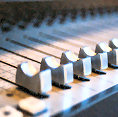 From homerecording.com, a collection of approaches to mixing:
From homerecording.com, a collection of approaches to mixing:
First thing is to do the faders up listening. If you’re a member of the band, or the engineer, or even worse both (as well as the song writer and the overall aranger of the songs….like I am), then TRY REALLY HARD to forget that. You have to become the mixer and listen to the track with fresh ears. Once you done the faders up listen a few times, you will have a pretty good idea of how the track goes …
Here, the folks on Gearslutz discuss modest low-end microphones. They list some great options if you’re in the market for a decent pro-sumer microphone:
I’m a drummer and I’ve always been satisfied with a D112 on the kick and an SM57 on the snare. I’ve got a very old pair of Oktava mk012s that I love for overheads. I’ve also used these for room mics and acoustic guitar with nice results… SM57 is good enough honestly on a snare. If you can’t make a snare pop with a 57, it’s not the mics fault.
(The thread introduced me to Sweetwater’s customers top mic picks page, which, depending on how you view Sweetwater’s customers, could also be a handy reference.)
Finally, here’s a thread with some interesting thoughts on modulating tape speed to change a recording’s character:
if you were to take the original tracks and layer them with the slowed down tracks (providing that the tracks weren’t *that* slowed down and could occassionally be resynched) then yes, the sound will get thicker. Simply slowing the tape speed down though will do absolutely NOTHING to “fatten” the sound. No additional overtones are added, no distortion should be added (provided your tape machine is properly calibrated) and even if it were, I doubt it would be the euphonic type of distortion you’d be looking for …
I’m not sure how effective the trick would be for fattening the sound, especially in a tape-less DAW, but if you’ve got a “try anything once” mindset here’s Audio Mastermind’s list of free pitch-shift VST plugins.
Previously: The Big Page of Mix Tutorials
Tags: microphones, mixing


No comments
Comments feed for this article